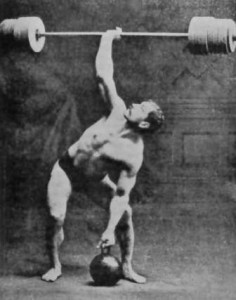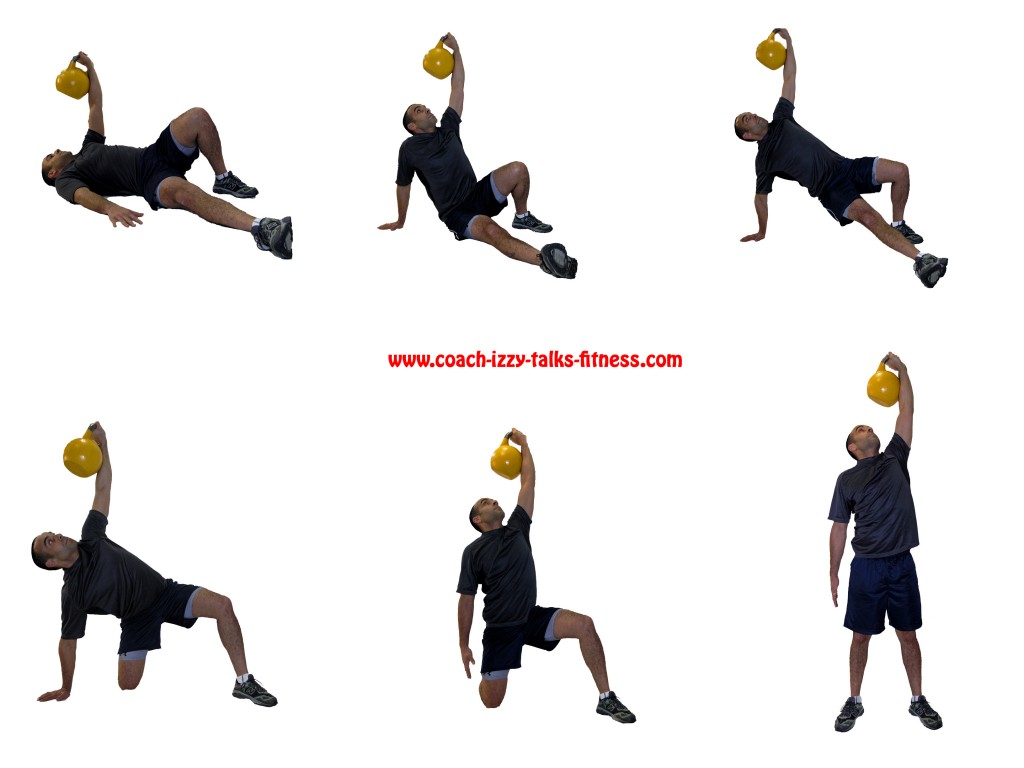What are you getting all worked-up about?

By
Coach Izzy
The taste of his regurgitated meal hinted the inevitable if he continued. Was it too late to back-out? How he wished common sense had guided his decision instead of the bravado that made him select a weight heavier than suggested.
But it looked so deceptively easy, and it was only 3 sets 5 reps per side, how could he have known?
He was now, in his second set and just finished one side, his strong side. He had another 5 to go on his weak side, and then another set. His earlier derision haunted him and kept replaying in his head. He had never seen, let alone done this exercise, why did he have to say that’s not so bad?
His diaphragm voiced its protest and his stomach acridly reminded him why it is a bad idea to have a heavy meal prior to a kettlebell workout, more so if it involves the infamous Turkish Get-Up.
Ah, the Turkish Get-Up! Its mere mention brings groans of protest and anxiety as those acquainted know what’s about to come. The extensive execution of each repetition, the guttural nature of its principle, and the investment of focus it demands. Groaning, huffing, and puffing frame its execution and very few things demand so much out of you like the Turkish Get-Up.
Yet exhilaration follows the punishment, the feeling that something this awkward could be performed so gracefully, and looking back we say it wasn’t so bad. For that moment, we love the Turkish Get-Up and everything is right with the world.
Wow, we are a twisted bunch!
And we keep coming back for more, why would that be? I dare say we feel we get so much out of this grueling exercise, we make sure to visit it often. Unfortunately, a few get too emotionally involved and make it appear as though performing Turkish Get-Ups will bestow them with unearthly powers akin to walking on water. They go as far as declaring it the most functional, the most real life, the savior of strength training, and a plethora of nonsense. Let’s take a deeper look and find out why it doesn’t need the overkill peppering of emotionally charged statements.
The History
 There are many claims as to the story behind the Turkish Get-Up. Some mention it was named after the ancient pit fighters of mythical battles, but I have not been able to find anything to corroborate these statements. If somebody has some references, please share! We are all eager to learn more.
There are many claims as to the story behind the Turkish Get-Up. Some mention it was named after the ancient pit fighters of mythical battles, but I have not been able to find anything to corroborate these statements. If somebody has some references, please share! We are all eager to learn more.
What’s for sure is that Turkish Get-Ups were a staple of strongman shows of the late 1800s and early 1900s. They were part of a repertoire of classic lifts like the bent press, two hands anyhow, and difficult body weight exercises. The Turkish Get-Ups were performed with barbells, people, and of course kettlebells.
Regardless of the veracity of the story and claims, there is no doubt athletes throughout history knew of the benefits of the Turkish Get-Up for overall strength, conditioning, and trunk/core endurance. We benefit from their experience and the lessons they passed to our generation to improve our conditioning and health.
The Claims
The outrageous claims ruining the credibility of the Turkish Get-Up are rooted in the efforts vested to make it imitate sports skills. Mixed martial artists are told the exercise simulates how they will overcome their opponents, climbers are told the exercise mimics the awkward positions they will find as they conquer pinnacles, and regular fitness enthusiasts are told no other exercise has a load outside the body like the Turkish Get-Up.
Blah, blah, blah!
I have no doubt some of those benefits are possible, but they just don’t happen by trying to imitate mechanical demands. In fact, the late Dr. Mel C. Siff in his book Supertraining, along with Tom C. Purvis of the Resistance Training Institute RTS ® warn about the fallacy of trying to replicate sport specific movement patterns under different circumstances. They make it clear there is an abysmal difference between sports specific training and mimicking.
Mimicking loads a motor pattern without care of the direction of the load or its nature, thereby deteriorating the very motor skills they are trying to enhance. On the other hand, true sports specificity addresses the mechanical demands of skills to ensure they are performed smoothly and efficiently.
The MMA will fight another MMA, not a kettlebell. They will benefit from the problem solving skills the Turkish Get Ups impose, not from imitating a melee with an inert object. Ditto for other activities.
Why The Turkish Get-Up Rocks
In case you thought I was bashing the Turkish Get-Up, you could not have been more wrong. Addressing the fallacies tarnishing this beautiful exercise is not even close to bashing it. You may see it as such if you are attached to the emotions of the exercise rather than its mechanics, but if you read openly, you will see there are no condescending remarks about it.
Going back to the topic, what makes the Turkish Get-Up such an awesome exercise is that you don’t need a lot of weight to get started. A small load at the end of a long lever arm requires significant mechanical force to overcome it. It is undeniable principle of physics and what makes the Turkish Get-Ups so brutally yummy. Can you do heavy Turkish Get- Ups? If you have the skill and strength, absolutely. The point is you can benefit from it, even without heavy loads.
Execution
For illustration purposes, the Turkish Get-Up will be addressed in two different stages and starting with the bell in the left arm. The Ascending Phase is when you get up from the floor to standing up with the arm overhead, and the Descending Phase is the methodical return to the floor.
The Ascending Phase

- Lie flat on your back and press a kettlebell straight up with your left arm to lock out.
- Left leg bent, left foot flat on the floor, and your right leg straight. Your right arm will be on your right side, roughly at forty-five degrees with the palm down.
- Keeping the bell pressed, push off with your left leg to your right.
- As you roll to your right, put your weight on your right hand. Keep rolling and rising up until your weight is supported by your right hand and left foot. Keep the right leg straight.
- Take a deep breath and lift your hip off of the floor. As you rise up, slide the right leg behind you, ending up kneeling on your right knee.
- Stand up, keeping the bell overhead to complete this phase.
The Descending Phase

- Keeping the bell overhead, start by kneeling on your right knee. Keep your left foot flat and firm on the ground.
- Keeping your right arm straight put your right hand on the floor.
- With your right hand and left foot firm on the ground, lift your right leg, bring it to the front, and straighten it.
- Roll back slowly to the starting position.
- Reset and repeat.
- Mirror the motions for the right arm.
Dorsiflexion or Plantar Flexion, Which One is Better?
Many times I hear this question from well-meaning fitness enthusiasts who want to know which position of the foot is more functional during the kneeling phase of the Turkish Get-Up. That’s like asking whether a steak knife is more functional than a butter knife.
If you are not acquainted with the terms, plantar flexion during the kneeling phase means the ball of the foot and toes of the kneeling leg are against the floor. During dorsiflexion, the entire top of the foot is against the floor.
Which one is more functional?
It depends!
What do you want to accomplish? What can you handle? Plantar flexion will allow you to take advantage of the stretch reflex generated by the foot but it will push the knee against the ground. Dorsiflexion will be easier on the kneeling joint but it will shift most of the load to one leg. Which of these circumstances suit your goals and conditions better?
That’s how you determine which version is more functional.
Tips to Enhance the Turkish Get-Up
Let’s conclude with a few tips to enhance your performance in this exercise. These tips address the most common issues found while performing Turkish Get Ups.
Keep your eye on the bell – Where the head goes the body follows. You may need to divert your gaze temporarily from time to time but your eyes should be on the bell to guide you.
Press the weight away from you – This will keep your arm steady and prevent the noodle-arm. Many times when people claim the exercise is too difficult or the weight too heavy is because they’re not keeping enough tension and the arm is too loose.
Moving fast does not mean rushing! – In the haste to get it over with or thinking speed means mastery, many lifters rush through the steps of the Turkish Get-Up and end up performing a sloppy version of the exercise. There’s nothing wrong with performing the movement fast as long as it done properly.
Don’t be a zombie – Pay attention! Seriously, pay attention. If you can chat or get distracted while doing the Turkish Get-Up you either need a heavier weight or a more difficult version. Keep challenging that body!
Now that we are more acquainted with the virtues and demands of this great exercise, it is time to grab our kettlebell and execute a few rounds to honor the Turkish Get-Up.
I’ll see you on the exercise floor!
____________________________________________________
My gratitude to Sal DeRosalia of Bainbridge Crossfit Outcome for demonstrating the exercise.